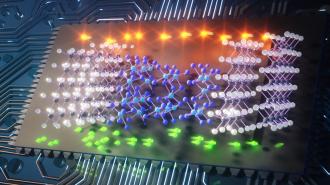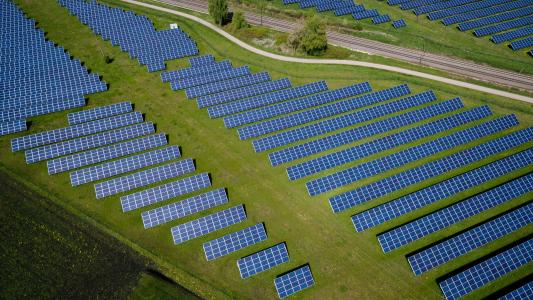This article is an installment of Future Explored, a weekly guide to world-changing technology. You can get stories like this one straight to your inbox every Thursday morning by subscribing here.
Dutch researchers have done the “impossible.”
By creating a new kind of superconductor, they have potentially unlocked a technology that could make computers hundreds of times faster — a breakthrough potentially on the scale of the first electronics revolution.
“This will influence all sorts of societal and technological applications,” researcher Mazhar Ali from the Delft University of Technology (TU Delft) predicts. “If the 20th century was the century of semi-conductors, the 21st can become the century of the superconductor.”
Electricity 101
Outside the nucleus of an atom are negatively charged particles called electrons, which can flow from one atom to another — that movement is electricity.
In some materials, electrons are tightly bound to the nucleus and don’t flow easily — those materials are insulators. In others, like copper and silver, electrons are loosely bound and can easily move from one atom to another — those are conductors.
Semiconductors are materials that fall between conductors and insulators — silicon is a commonly used semiconductor.
“If the 20th century was the century of semi-conductors, the 21st can become the century of the superconductor.”
Mazhar Ali
We rely on conductors and semiconductors to transport electricity — we use wires made of copper to send it from power plants to our homes, for example, and silicon chips to control its movement inside our electronic devices.
All conductors and semiconductors resist the flow of electrons at least somewhat. That means every time an electron moves from one atom to another, a little bit of energy is lost in the form of heat.
Those little bits of lost energy add up: about 5% of the electricity generated at US power plants never makes it to people’s homes. In our devices, meanwhile, overheating limits how fast processors can work and can cause programs to crash.
Superconductors
In 1911, a Dutch physicist discovered that, under the right circumstances, some materials don’t lose any energy when their electrons move from one atom to another. Those are called superconductors, and one example is aluminum when cooled to -271 degrees Celsius (-457 degrees Fahrenheit).
If we could replace conductors or semiconductors with superconductors, our electronic devices could become hundreds of times faster, without wasting energy in overheating, and we would be able to save billions of dollars in electricity transmission losses every year.
Superconductors don’t lose any energy when their electrons move from one atom to another.
However, one major problem is that electricity flows without resistance in both directions through a superconductor.
For most applications, we need to be able to move a current in one direction, from point A to B — in the 1970s, IBM researchers determined we’d never be able to use superconductors in computers, for example, unless someone figured out one-way superconductivity.
It is possible to guide a current through a superconductor using a magnetic field, but those are hard to control on the nanoscale.This has significantly limited applications for superconductors — today, they’re mainly reserved for things like MRI machines and maglev trains.
The discovery
Researchers at TU Delft have now done the seemingly impossible, by getting electricity to flow through a superconductor in one direction without the use of magnets. They call it a “Josephson diode.”
The key design was using a 2D layer of a material — meaning, it’s only one atom thick — that has a built-in electromagnetic field. That material (called Nb3Br8) was then sandwiched between 2D layers of a superconductor (called NbSe2).
“Technology which was previously only possible using semi-conductors can now potentially be made with superconductors.”
Mazhar Ali
When an electric current is applied to this sandwich, the electrons encounter no resistance when flowing in one direction — but in the opposite direction, they encounter a lot more resistance — about as much as a normal conductor.
The researchers aren’t sure yet how their diode works — “People have a rough idea, but a rigorous theory does not exist yet,” Ali told New Scientist — but they believe their discovery could have huge implications.
“Technology which was previously only possible using semi-conductors can now potentially be made with superconductors using this building block,” said Ali. “This includes faster computers, as in computers with up to terahertz speed, which is 300 to 400 times faster than the computers we are now using.”
The next steps
A one-directional superconductor without magnets is a major breakthrough, but the TU Delft team still has hurdles to surmount before its discovery can be useful outside the lab.
One is temperature — the Josephson diode currently has to operate at -271°C (-455.8°F), which wouldn’t be practical for most applications.
The plan now is to experiment with superconducting materials known to work at higher temperatures — if the diode can work at -196°C (-321°F) or above, the cooling could be handled by liquid nitrogen, which is already used to manage heat at data centers.
Another hurdle is figuring out how to scale up production.
“While it’s great that we proved this works in nanodevices, we only made a handful,” said Ali. “The next step will be to investigate how to scale production to millions of Josephson diodes on a chip.”

We’re not going to be able to keep the chips in our phones and laptops hundreds of degrees below zero any time soon. But if the TU Delft team can overcome these remaining challenges, Ali sees the diodes being used in places where advanced cooling systems are already installed, such as supercomputer facilities.
They could also be utilized at server farms, and with more and more computing happening in the cloud, it’s possible that one day everyone will be able to leverage the power of superconducting computers over the internet.
“The existing infrastructure could be adapted without too much cost to work with Josephson diode-based electronics,” Ali said. “There is a very real chance, if the challenges discussed … are overcome, that this will revolutionize centralized and supercomputing!”
We’d love to hear from you! If you have a comment about this article or if you have a tip for a future Freethink story, please email us at [email protected].






